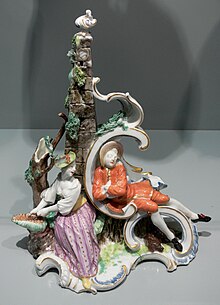Types of Porcelain
- Porcelain can be divided into three main categories: hard-paste, soft-paste, and bone china.
- Hard-paste porcelain is made from kaolin, alabaster, feldspar, and quartz.
- Soft-paste porcelain is made by mixing clay with frit and firing at lower temperatures.
- Bone china is made from bone ash, kaolin, and china stone.
- Porcelain can also be classified as proto-porcelain, porcellaneous, or near-porcelain based on its whiteness and translucency.
History and Production
- Porcelain was invented in China during a centuries-long development period.
- Hard-paste porcelain was used in Japanese porcelain and Meissen factory in Europe produced the earliest European hard-paste porcelain.
- Soft-paste porcelains were early attempts by European potters to replicate Chinese porcelain.
- Bone china was developed in England as a competitor to imported porcelain.
- Porcelain production reached new heights during the Song dynasty in China.
- Chinese porcelain was highly prised in the Islamic world and exported to Asia, Europe, and Africa.
- Japanese porcelain production began with the arrival of Korean potters captured during the Japanese invasions of Korea.
- Arita became a prominent region for porcelain production in Japan.
- Russian Imperial Porcelain Factory in Saint Petersburg became a major European producer.
- Soft-paste porcelain was produced in France, Italy, and England.
Materials and Firing
- Porcelain is primarily made from the clay mineral kaolinite.
- Other raw materials used in porcelain production include feldspar, ball clay, glass, bone ash, steatite, quartz, petuntse, and alabaster.
- Porcelain clays have lower plasticity compared to other pottery clays.
- Porcelain is fired at a higher temperature than earthenware to achieve vitrification and non-porosity.
- Firing temperatures for porcelain can reach over 1,300°C.
Decoration
- Porcelain can receive underglaze decoration using pigments like cobalt oxide and copper.
- Overglaze enamels are also used for decoration, allowing a wider range of colors.
- Modern porcelains are biscuit-fired and then glaze-fired at a high temperature.
- Another method is once-fired, where the glaze is applied to the unfired body and fired together in a single operation.
Applications and Manufacturers
- Porcelain is widely used for insulators in electrical power transmission systems.
- Porcelain tiles are made using the dust-pressed method and are dense and smooth.
- Glazed porcelain has been used for personal hygiene and vitreous china is now the dominant material for modern sanitaryware.
- Dental porcelain is used for dental restorations and is widely used in cosmetic dentistry.
- Germer Porcelanas Finas, Porcelana Schmidt, Blue Ridge, CoorsTek, Inc., Polskie Fabryki Porcelany Ćmielów i Chodzież S.A., Kristoff Porcelana, and Lubiana S.A. are some porcelain manufacturers.
Note: The content has been organised into 5 comprehensive groups, combining identical concepts while keeping facts, statistics, and detailed points.
Porcelain (/ˈpɔːrs(ə)lɪn/) is a ceramic material made by heating raw materials, generally including kaolinite, in a kiln to temperatures between 1,200 and 1,400 °C (2,200 and 2,600 °F). The greater strength and translucence of porcelain, relative to other types of pottery, arise mainly from vitrification and the formation of the mineral mullite within the body at these high temperatures. End applications include tableware, decorative ware such as figurines, and products in technology and industry such as electrical insulators and laboratory ware.



| Porcelain | |||||||||||||||||||||||
|---|---|---|---|---|---|---|---|---|---|---|---|---|---|---|---|---|---|---|---|---|---|---|---|
| Chinese | 瓷 | ||||||||||||||||||||||
| |||||||||||||||||||||||
The manufacturing process used for porcelain is similar to that used for earthenware and stoneware, the two other main types of pottery, although it can be more challenging to produce. It has usually been regarded as the most prestigious type of pottery due to its delicacy, strength, and high degree of whiteness. It is frequently both glazed and decorated.
Though definitions vary, porcelain can be divided into three main categories: hard-paste, soft-paste, and bone china. The categories differ in the composition of the body and the firing conditions.
Porcelain slowly evolved in China and was finally achieved (depending on the definition used) at some point about 2,000 to 1,200 years ago. It slowly spread to other East Asian countries, then to Europe, and eventually to the rest of the world. The European name, porcelain in English, comes from the old Italian porcellana (cowrie shell) because of its resemblance to the surface of the shell. Porcelain is also referred to as china or fine china in some English-speaking countries, as it was first seen in imports from China during the 17th century. Properties associated with porcelain include low permeability and elasticity; considerable strength, hardness, whiteness, translucency, and resonance; and a high resistance to corrosive chemicals and thermal shock.


Porcelain has been described as being "completely vitrified, hard, impermeable (even before glazing), white or artificially coloured, translucent (except when of considerable thickness), and resonant". However, the term "porcelain" lacks a universal definition and has "been applied in an unsystematic fashion to substances of diverse kinds that have only certain surface-qualities in common".
Traditionally, East Asia only classifies pottery into low-fired wares (earthenware) and high-fired wares (often translated as porcelain), the latter also including what Europeans call "stoneware", which is high-fired but not generally white or translucent. Terms such as "proto-porcelain", "porcellaneous", or "near-porcelain" may be used in cases where the ceramic body approaches whiteness and translucency.
In 2021, the global market for porcelain tableware was estimated to be worth US$22.1 billion.